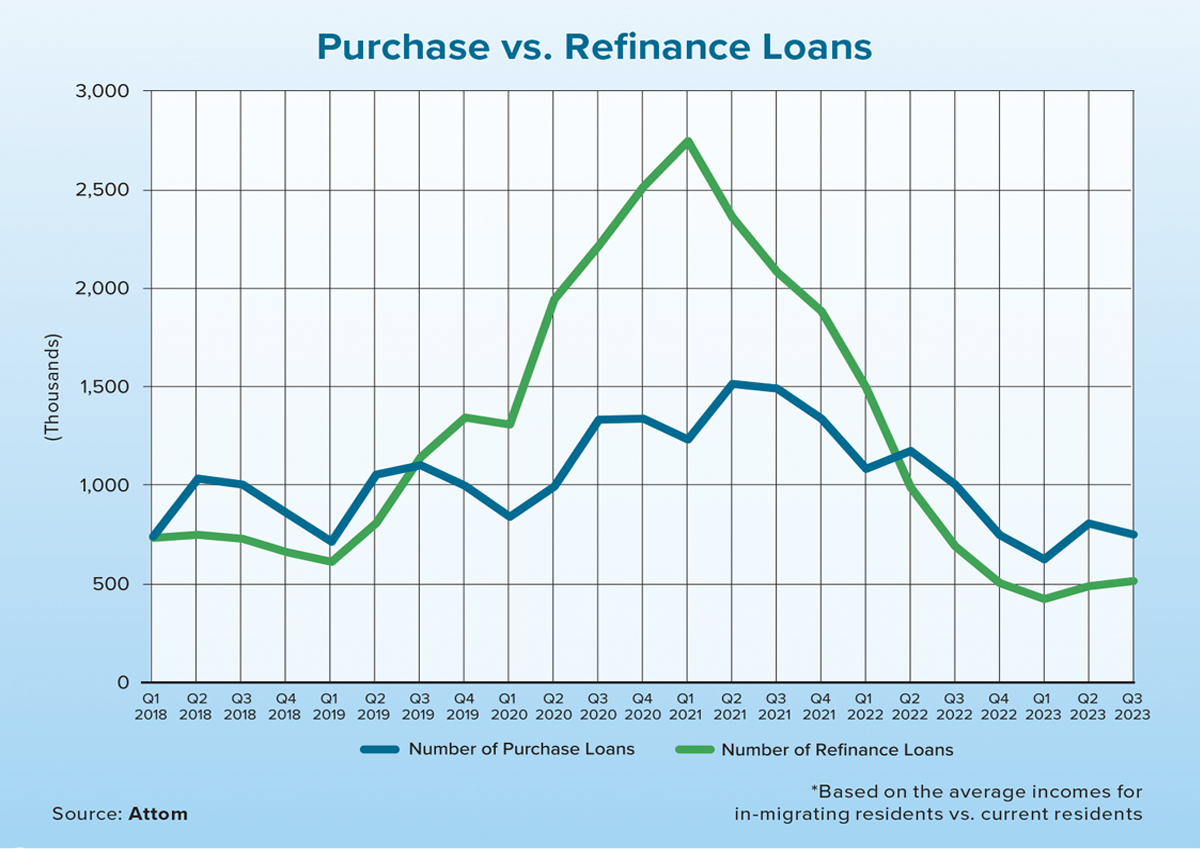The combination of increasing home prices and elevated mortgage interest rates continues to plague residential mortgage originations. In third quarter of 2023, 1.54 million mortgages secured by residential property (one to four units) were issued in the U.S., a 3% decline from second quarter of 2023, according to Attom’s U.S. Residential Property Mortgage Origination Report. Those numbers show a continued downward trend in originations, with nine out of the past 10 quarters marking a decline. Year over year, residential lending was down 26% and a whopping 63% from a high point in 2021.
Despite rising interest rates, refinances increased for the third quarter, while purchase and home- equity lending declined. Refinances increased 5% in the quarter to 516,500 while purchase loans declined roughly 7% to about 752,000. Home-equity originations likewise dropped 7% to 272,000.
These changes weren’t enough to make any major shifts in the overall originations picture. Purchase loans continued to make up about 50% of the mortgages issued in the third quarter, while refinances still totaled roughly 30% and home-equity loans was just under 20%. While this remained roughly steady quarter- over-quarter, it shows a marked shift from just two years ago, when low interest rates led to refinances making up nearly two-thirds of all mortgages and purchase loans merely one-third.
After a brief spike in purchase activity in the second quarter (typically the strongest period for home sales), purchase originations returned to a downward trajectory in the third quarter, and refinances were the surprising bright spot in the overall originations picture.
Although the national numbers reflect the larger economic forces in play, local and regional statistics show some glimmers of hope for originators. While 63% of the 201 metropolitan statistical areas analyzed in the report showed a decline in overall lending from second to third quarter 2023, there were some areas that showed improvements. Among metros with a population of at least 1 million, the areas with the largest increases include: Buffalo, New York (15.2% increase); Grand Rapids, Michigan (9.8%); Honolulu (7.9%); New York City (6.2%); and Detroit (5.6%).
The data shows similar local trends among refinance loans. In metros with a population of at least 1 million, the largest quarterly increases in refinances were in: Tucson, Arizona (up 24.3%); Honolulu (17.8%); Indianapolis (14.6%); Houston (14.6%); and Dallas (14.1%).
Although conventional mortgages continue to dominate residential lending, loans backed by the Federal Housing Administration (FHA) have been increasing recently. Third quarter 2023 marked the eighth straight quarter where FHA loans have increased their percentage of all lending. FHA loans made up 15.2% of all residential property loans originated this past third quarter, up from 13.7% in second quarter 2023 and 11.3% in third quarter 2022.
The overall originations trends point to continued rocky times for the mortgage industry. Recent projections for stable interest rates, if they hold true, could help reduce further declines and keep lending steady going forward. ●
Author
-

Rob Barber is CEO of Attom, curator of the nation’s premier property database. After joining the company in 2015, Barber spearheaded the creation of the Attom Data Warehouse. A 25-year veteran in the real estate information-services industry, Barber directs the ongoing product innovation that leverages the company’s data warehouse and data-delivery platforms, which fuel real estate transparency.





